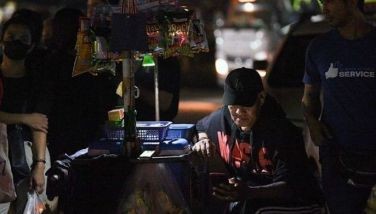From one crisis to another

We leave behind 2009 thankful that the global financial crisis that rocked the world’s strongest economies in 2008 had been kinder to our island community of 92 million Filipinos.
While the world’s gross product level will still be lower by an estimated 2.2 percent during the year compared to last year, the global economy had already exhibited growth in the second and third quarters of 2009.
Signs of new life are now being seen in the United States. In the third quarter, the world’s biggest economy chalked a 2.8-percent growth. Economists are now looking at a growth in gross domestic product of between three and four percent in the last quarter of the year. Japan experienced its best growth rate in two years during the third quarter too.
We are seeing emerging economies leading growth. India, for example, is up by an impressive 7.9 percent in the third quarter. Some color is returning to the stock markets, and the general nervousness of investors has been replaced by cautious optimism.
Even if unemployment remains a serious global issue, Filipinos have realized that there are still jobs waiting for them in many parts of the world. Our doctors, nurses, engineers, and teachers are being welcomed in many parts of Europe and the US in spite of their respective domestic problems.
The world’s financial advisers have declared that the worst has passed, although they hasten to add that the global situation remains tenuous. Expect uncertainties and surprises, such as the Dubai debt moratorium declaration last month.
Dubai debacle
It could very well just be a blip in the generally improving global landscape, but the announcement of city-state Dubai that its main corporate arm, ports-and-property conglomerate Dubai World, would be holding back payment for six months of its almost $60-billion loans still put a temporary damper on returning investor confidence.
While many economists shrugged off any contagion implications, especially among Middle East economies, there was still a lot of speculation about the Dubai debacle. Talks were largely fueled by the fact that Dubai’s debt crisis hides behind a series of screens of asset ownership and liability.
Dubai is regarded as the poorer cousin of the seven states that make up the United Arab Emirates. In an effort to shore up dwindling oil revenues, it embarked on an ambitious building project seven years ago. The global recession and lower crude oil prices in the first quarter of 2009, however, forced as many as half of construction works to be put on hold.
UAE’s central bank is sure to back up Dubai, but in the absence of any pointed assurances of how much, there is no firm word yet on when most of the stalled projects will resume. In the meantime, thousands of expatriate workers are being sent back to their home countries.
The Philippine government has prepared for a fall-out from Dubai’s burst property bubble, including finding other employment opportunities for potentially displaced overseas Filipino workers in other UAE states including the more financially solid Abu Dhabi.
With rising oil prices, a global economy on the mend, and a rescue package being hammered to bail out Dubai, 2010 could very well be a smoother ride for everyone – at least, as far as economic growth is concerned.
Climate change challenge
Getting the global economy back on the road to recovery, however, may take a back hand next year as the world is forced to look at mounting environment problems caused by insufficient cuts in emission levels by both developed and emerging economies.
For the Philippines, there is no grimmer reminder of this malady than the tropical depression Ondoy’s heavy downpour last September. Till today, there are still towns and villages that remain submerged in water, a clear warning that climate change may not be kinder to our islands.
In the latest bulletin issued by over 400 scientists making up the Inter-government Panel on Climate Change, the Philippines is seen as one among the many island states that are threatened by a rise in world sea levels. Should climate temperatures climb 2 degrees more than pre-industrial levels, the IPCC warned that waters could rise by as much as nine meters.
Even as President Arroyo announced receiving $380 million in aid from the World Bank and the Asian Development Bank after coming home from Copenhagen, this is no comfort to the thought that our nation could lose whole towns and cities, which would displace millions of people from their current homes.
In fact, the establishment of a Copenhagen Green Climate Fund committed to raising $100 billion yearly by 2020 will not be enough to mitigate widespread hunger in many parts of the world that will experience severe droughts, and homelessness in countries like the Philippines that will be inundated by floods.
Basic side-agreement
It may not be the perfect end, but Copenhagen’s BASIC agreement is still something to look forward to. Going to the last 24 hours of the two-week climate summit, the U.S. signed a non-binding agreement with Brazil, South Africa, India and China (BASIC) that opened the possibility of forging a more conclusive contract next year.
Compared to the so-called Copenhagen Accord that was supposed to cap the 15th Conference of Parties under the supervision of the United Nations, the BASIC side-deal is a welcome surprise after days of frustrating negotiations and barbed exchanges among participating nations.
As had been expected even before the Copenhagen meetings started, a real agreement that could replace the binding Kyoto commitments due to expire in 2012 may only be possible next year. Meanwhile, the clock of climate change continues to tick away.
The world will have to get its act together. Otherwise the global financial crisis of 2008 will only be replaced by a bigger world catastrophe that no stimulus package will be able to mitigate.
2009 Philippine Collegiate Championship wrap-up
Other than the elite “Sweet 16” members, there are collegiate teams that deserve recognition for their achievements as they strove to win honors for their respective schools during PCCL’s 2009 Collegiate Championship games.
These teams went beyond winning their respective “mother league” titles and successfully competed with other league champions to win the prize awards as “regional champions.” While failing to reach the “Sweet 16” Finals this year, they have set their sights on next year’s games. The following are the regional champions:
North/Central Luzon Champion – Lyceum of Subic Bay Sharks, UCLAA champion, won by beating the champions from Vigan, Baguio and Pangasinan collegiate leagues.
South Luzon-Bicol Champion – University of Nueva Caceres Greyhounds, Naga City Intercollegiate champion, topped the champions from Quezon, Legaspi, Tabak and Sorsogon to win the regional award.
Visayas Champion (outside Cebu) – West Negros University Mustangs, NOPSSCEA champion, repeated its mastery over the champion teams from Dumaguete, Bohol, Ormoc and Tacloban.
Mindanao Champion – Holy Trinity College Wildcats, GenSan Intercollegiate champion, is a first time regional winner beating the champion teams from Cagayan de Oro, Davao, Zamboanga City, Dipolog and Sibugay.
Visit www.CollegiateChampionsLeague.net for more highlights of the recently concluded PCCL 2009 Philippine Collegiate Championship games.
Should you wish to share any insights, write me at Link Edge, 25th Floor, 139 Corporate Center, Valero Street, Salcedo Village, 1227 Makati City. Or e-mail me at [email protected]. For a compilation of previous articles, visit www.BizlinksPhilippines.net.
- Latest
- Trending




























